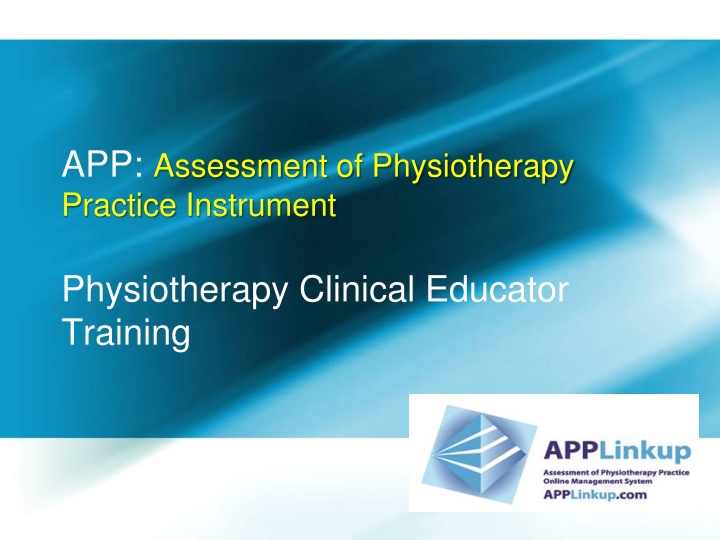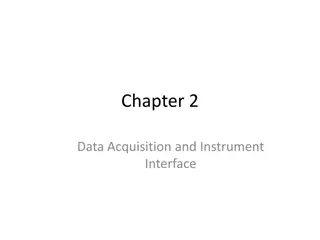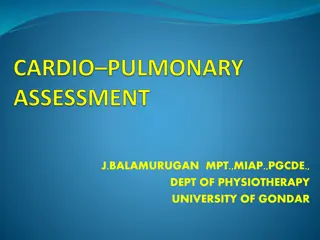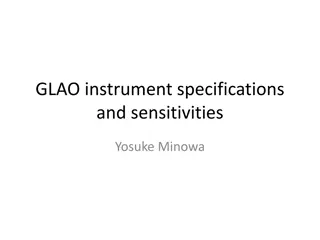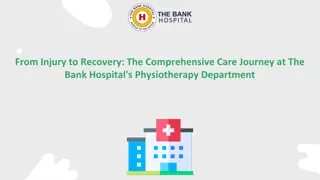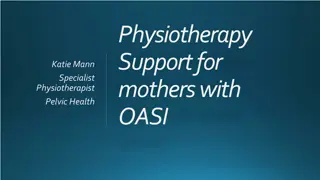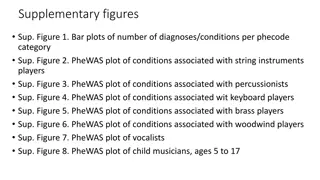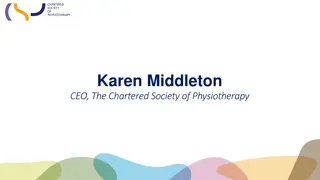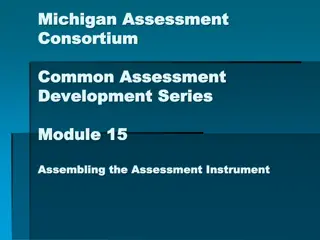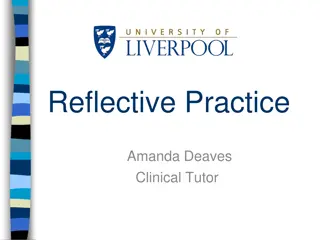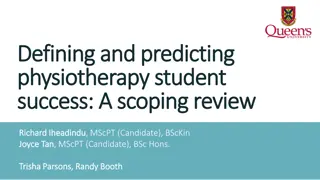Assessment of Physiotherapy Practice Instrument Overview
This content provides an in-depth look at the Assessment of Physiotherapy Practice (APP) instrument used for evaluating student performance on clinical placements in Australian Physiotherapy Programs. It covers the development, components, and usage of the standardized instrument, along with its role in guiding students towards improvement and meeting professional standards. Readers will gain insights into the benefits of using the APP for formative feedback and summative assessment, enhancing their ability to assess students effectively in clinical education settings.
Uploaded on Jul 23, 2024 | 6 Views
Download Presentation

Please find below an Image/Link to download the presentation.
The content on the website is provided AS IS for your information and personal use only. It may not be sold, licensed, or shared on other websites without obtaining consent from the author.If you encounter any issues during the download, it is possible that the publisher has removed the file from their server.
You are allowed to download the files provided on this website for personal or commercial use, subject to the condition that they are used lawfully. All files are the property of their respective owners.
The content on the website is provided AS IS for your information and personal use only. It may not be sold, licensed, or shared on other websites without obtaining consent from the author.
E N D
Presentation Transcript
APP: Assessment of Physiotherapy Practice Instrument Physiotherapy Clinical Educator Training
Learning objectives By the end of this presentation you will: Understand the components of the APP Be able to use the APP instrument effectively in formative feedback and summative assessment Feel more comfortable in your role as assessor of students
APP development and use Currently used by all Australian Physiotherapy Programs for assessment of student performance on clinical placements All graduates must meet same competencies/standards outlined in Australian Standards for Physiotherapy Clinical educators dealing with multiple programs want one form that had evidence of validity and reliability APP developed and tested across 5 years with involvement of educators, managers, students and universities
The Roles of Assessment what does workplace based assessment do for students?
Role of assessment Directs students to knowledge skills & attitudes they are performing well & those requiring improvement (the formative role of assessment) Forms basis for development of strategies to change performance Tells students if they are meeting the standards grades, (the summative role of assessment)
The APP (Assessment of Physiotherapy Practice) Instrument
APP- Assessment Instrument Standardised instrument used nationally Valid and reliable instrument Identifies 7 domains of practice and lists 20 items considered fundamental to our profession Scores are determined by a rating scale used in conjunction with performance indicators APP is for use in core clinical units where student is meant to carry their own caseload
APP paper based & online APP is available in paper form or online www.APPLinkup.com is the link to the online interactive assessment system You can use either format, the guidelines are the same
5 point rating scale to rate each item 7 domains of practice 20 items Global rating scale Scoring rules
5 point rating scale to rate each item 7 domains of practice Performance indicators in drop down menu 20 items
Performance Indicators For each item List of observable and concrete behaviours Can guide feedback and grading for each item Examples of evidence of competence (or lack of) Designed to guide both students and educators Are not an exhaustive list of possible behaviours nor are they to be used as a checklist when assessing a student s performance
arrives punctually and leaves at agreed time calls appropriate personnel to report intended absence wears an identification badge and identifies self understands scope of expertise observes dress code completes projects/tasks within designated time frame reports inappropriate or unsafe behaviour of a co-worker or situations that are unsafe maintains appropriate professional boundaries with patients/clients and carers demonstrates appropriate self-care strategies (eg stress management) acts ethically and applies ethical reasoning in all health care activities applies ethical principles to the collection, maintenance, use and dissemination of data and information acts within bounds of personal competence, recognizing personal and professional strengths and limitations 4.Demonstrates teamwork demonstrates understanding of team processes contributes appropriately in team meetings acknowledges expertise and role of other team members and refers/liaises as appropriate to access relevant services advocates for the patient/client when dealing with other services collaborates with the patient/client and the health care team to achieve optimal patient/client outcomes cooperates with other workers who are treating and caring for patients/clients Communication 5.Communicates effectively and appropriately - Verbal/non- verbal greets others appropriately questions effectively to gain appropriate information listens carefully and is sensitive to patient/client and carer views respects cultural and personal differences of others gives appropriate, positive reinforcement provides clear instructions uses suitable language & avoids jargon demonstrates an appropriate range of communication styles (eg patients/clients, carers, administrative and support staff, health professionals, care team) recognises barriers to optimal communication uses a range of communication strategies to optimize patient/client rapport and understanding (eg hearing impairment, non- English speaking, cognitive impairment, consideration of non-verbal communication) appropriately uses accredited interpreters maintains effective communication with clinical educators actively explains to patients/clients and carers their role in care, decision-making and preventing adverse events actively encourages patients/clients to provide complete information without embarrassment or hesitation communication with patient/client is conducted in a manner and environment that demonstrates consideration of confidentiality, privacy and patient s/client s sensitivities negotiates appropriately with other health professionals 6.Communicates effectively and appropriately - Written writes legibly completes relevant documentation (record keeping including documentation of all physiotherapy assessments and interventions, statistical information as required by the organization, referral letters, written communications with appropriate patient/client consent, case notes, handover notes) accurately and consistently maintains records compliant with legislative medico-legal requirements complies with organisational protocols and legislation for communication adapts written material for a range of audiences (e.g. provides translated material for non-English speaking people, considers reading ability) Professional Behaviour 1.Demonstrates an understanding of patient/client rights and consent understands when formal client consent is required informed consent is obtained and recorded according to protocol understands and respects patients /clients rights allows sufficient time to discuss the risks and benefits of the proposed treatment with patients/clients and carers engages patients/clients in discussion of the effects of treatments or no treatment records patient s/client s refusal of treatment and advises supervisor refers patients/clients to a more senior staff member for consent when appropriate advises supervisor or other appropriate person if a patient/client might be at risk works collaboratively and respectfully with support staff 2.Demonstrates commitment to learning responds in a positive manner to questions, suggestions &/or constructive feedback develops and implements a plan of action in response to feedback seeks information/assistance as required demonstrates self-evaluation, reflects on progress and implements appropriate changes based on reflection reviews and prepares appropriate material before and during the placement takes responsibility for learning and seeks opportunities to meet learning needs 3.Demonstrates practice that is ethical and in accordance with relevant legal and regulatory requirements follows policies & procedures of the facility advises appropriate staff of circumstances that may affect adequate work performance observes infection control, and workplace health and safety policies maintains patient/client confidentiality arrives fit to work Assessment 7.Conducts an appropriate patient/client interview (subjective assessment) positions person safely and comfortably for interview structures a systematic, purposeful interview seeking qualitative and quantitative details asks relevant and comprehensive questions politely controls the interview to obtain relevant information responds appropriately to important patient/client cues identifies patient s/clients goals and expectations conducts appropriate assessment with consideration of biopsychosocial factors that influence health. seeks appropriate supplementary information, accessing other information, records, test results as appropriate and with patient s/client s consent generates diagnostic hypotheses, identifying the priorities and urgency of further assessment and intervention completes assessment in acceptable time 8.Selects appropriate methods for measurement of relevant health indicators selects important, functional and meaningful outcomes relevant to treatment goals, including those to identify potential problems chooses appropriate methods/instruments to measure identified outcomes across relevant assessment domains e.g. impairment, activity limitations, participation restriction, well-being and satisfaction with care 9.Performs appropriate assessment procedures (physical assessment) considers patient/client comfort and safety respects patient s/client s need for privacy and modesty (eg provides draping or gown) structures systematic, safe and goal oriented assessment process accommodating any limitations imposed by patient s/client s health status Plans assessment structure and reasoning process using information from patient/client history and supportive information demonstrates sensitive and appropriate handling during the assessment process
Global Rating Scale (GRS) In your opinion as a clinical educator, the overall performance of this student in the clinical unit was: Not adequate Adequate Good Excellent Complete only at summative assessment (Final) Complete after rating all 20 items Typically, this student demonstrates most items at an . ..level
Global rating scale Captures complexity of expert performance Most reliable measure of clinical skill that is also sensitive to increasing levels of expertise. Better measure of complex interactions such as communication, rapport etc. Assists identification of borderline students There is evidence that a combination of global scores and items are complimentary methods
How to complete the APP: using the rating scale
Scoring the APP Scoring is based on direct observation and interpretation of student performance. Circle the rating from 0 4 that best represents your judgement of the student s level of performance at the end of the unit
Scoring the APP Use Not Assessed only if student has not had an opportunity to demonstrate the behaviour Circle only one number for each item Complete the global rating scale at the end of unit
In the APP the final rating for each item quantifies the level of performance achieved relative to that of beginning practitioner standards of practice This is the passing standard 0 1 2 3 4 N/A
APP scoring 0 1 2 3 4 N/A 0 & 1 = not achieving the minimum acceptable entry level standard of performance 2 = minimum acceptable standard 3 & 4 = indicating good and excellent performance N/A: not assessed
Why choose entry level/minimally competent as passing standard? Enables ranking of students relative to a common standard. May be the only time student experiences a particular clinical area Better standardisation between assessors Time based passing standard (where student is at in their program) is unpredictable, unacceptable & not transparent Allows more targeted discussion, training More effective in driving learning in students
So what does a student who is performing at a minimally competent, passing standard look like?
Entry Level Description Passing standard Take a few minutes and write down phrases to complete this sentence A student is performing at the entry level/minimally competent standard when they ..
Passing Standard/Entry Level Description Adequate assessment Adequately communicate, patient understands Formulate treatment plan Safe, to independently manage a patient Ability to think and reflect, self evaluate Willingness to learn and take on feedback teachable, safe, responsive, adequate, appropriate
Passing Standard/Entry Level Description Employable Able to carry a case load of basic patients with some supervision Measure their own outcomes Maintain safety Write notes legibly, accurately work independently and with a team Ask questions know their limitations
Entry Level typically a student would demonstrate an understanding of patient centered physiotherapy practice and are able to manage a variety of patients such that the major problems are identified, goals established and intervention is completed safely, professionally, effectively within in a reasonable time frame. While achieving this, the student is aware of their limitations and where to seek assistance.
Entry Level Remember entry-level is the minimum demonstrated behaviour required for entry to the physiotherapy profession .not a measure of capacity to undertake specific workplace duties without any assistance/support
Higher level standard Remember a number of students achieve better than minimum standard ..this does not mean we should elevate our concept of entry level
When to use the APP instrument? Begin early Day 1 of the unit; end of week 1 (set expectations and learning objectives with student using APP) Mid-placement (formative feedback use performance indicators to give evidence of strengths and weaknesses) End of placement (summative assessment of items and global rating scale)
Mid unit formative feedback What will you do?
Mid unit formative feedback Use the APP items & performance indicators to discuss with student areas of strength and for improvement Student and educator both input into mid unit assessment Score the APP items only if you have enough evidence Provide specific examples of behaviour If you have items not assessed, need to view these before the end of unit
Mid unit formative feedback A score of 0 would be a matter of immediate importance Notify the university A score of 1 for any item warrants feedback and strategies to assist student to achieve a passing standard for the item
APP instrument Student & CE Begin early Student Mid unit feedback using the APP
End of unit summative assessment What will you do?
Summative Assessment Process Refer to APP Clinical Educator Resource manual for detailed explanation on use of instrument. Read the performance indicators within each aspect of practice Determine the appropriate score using the rating scale for each item Record the score(0-4) against each item Complete the global rating scale Refer to scoring rules
Summative Assessment After completing the APP identify trends (strengths/ weaknesses) Considers strategies for the student to progress in next unit Complete any additional pages of assessment documents (feedback, summaries etc) If any item is scored <2 in (final assessment) contact Uni to discuss prior to meeting with student. A student can still pass with a 2-3 items rated as a 1 but if more than this then really consider failing the student as they most likely need more time. Prepare for formal feedback session with student and discuss the outcome with them Sign documents and return to University
Summary: advantages of APP Reliable and valid instrument Led to reduction in burden on clinical educators Standardisation of assessment processes between universities Improved training of educators, reduction in duplication Opportunities to continue evaluation and refinement of APP and assessment approaches
